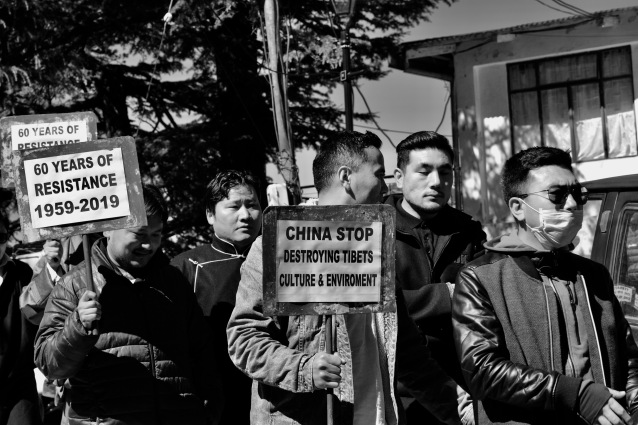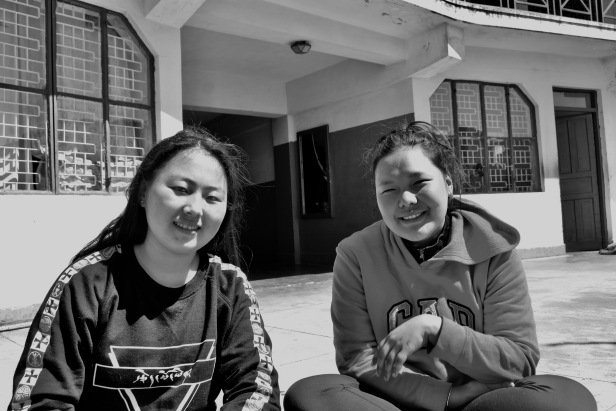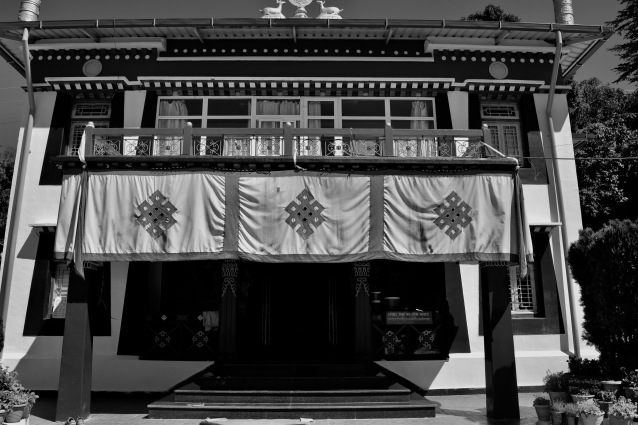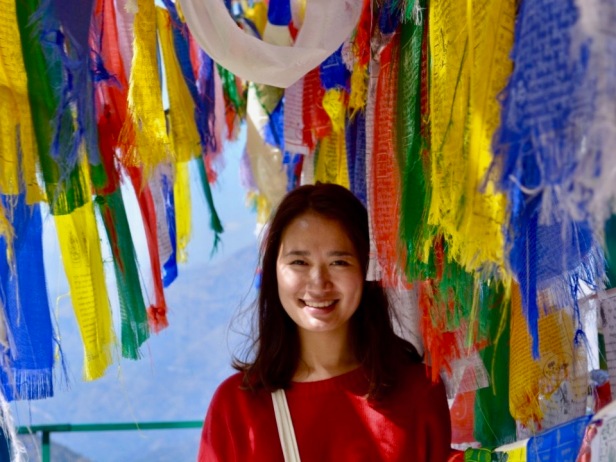Sixty years on, Tibetans continue struggle
Lhamo Tsering was only eight years old when she and her four cousins escaped Tibet on foot.
The only help they received was from four Nepali boys, paid and instructed by her mother to help the girls flee Chinese-annexed Tibet.
Almost twelve years after the journey, Tsering recalls the escape in an aloof, detached tone.
“We were scared, very scared,” Tsering said. “And we got no information while we were walking through jungles.” Unable to speak Tibetan, the Nepali boys simply used hand signals to communicate.
Running short on food, she and her cousins hid behind trees while the boys tried getting food from nearby villages. The girls were nearly caught thrice. Tsering’s mother had made the risk very clear.
The most dangerous part of the journey was crossing a wide, unruly river. The boys used ropes and walkie-talkies to get the girls across.
After two taxing days, the girls reached Nepal.
“I think I’m fortunate,” she said. “There are people who have taken up to two months to reach. They had to cross snow mountains and deal with frostbite and snow-blindness. Many have gotten caught also.”
In Nepal, the boys took the girls to a home, where they stayed for a month. After that, they were brought safely to Happy Valley, a settlement of about 5,000 Tibetans west of Mussoorie.
There, Tsering experienced culture shock — shocked to learn about her homeland.
She said, “When I was in Tibet, I thought Tibet was a part of China. I didn’t know much about Tibet. I just wasn’t connected to Tibetan culture.”
But in India, after being exposed to Tibetan culture without any suppression, she experienced something unprecedented: she felt Tibetan, she felt safe.
She said, “Now I actually have patriotic feelings towards my country and my culture.” She smiled: “No more fear.”
She shared her story while sitting on the floor of one of the many dormitories in Happy Valley. Earlier that morning, less than five minutes away, the peace march celebrating the 60th Tibetan National Uprising Day had begun.
At the march, adults were preparing to walk to Gandhi Chowk, holding up signs that called for Tibetan autonomy, action on Chinese exploitation of Tibetan resources, and the Dalai Lama’s return to Tibet. A man distributed yellow pamphlets explaining the history and significance of the date: March 10.

G. Rinchen, general secretary of the Tibetan Homes Foundation, said, “Sixty years ago, in 1959, Tibetans in Lhasa rose up against the Chinese. That is what today is about. We want the world to know what is happening in Tibet under China. China is trying to finish the Tibetan language, Tibetan religion, Tibetan culture, Tibetan race. We want the world to know that.”

According to Chonden, an active member of the local Tibetan community, the means of getting this message across through the march have softened over the years. Up until last year, the signs and posters directly targeted China and demanded Tibetan autonomy. This year, however, more environmental issues about exploitation of Tibetan resources were raised. And instead of harsh slogans, the peace marchers resorted to Buddhist chants about celebrating the Dalai Lama.
Chonden said, “We are not against the Chinese. We are simply against Chinese politics. That is why the march is more peaceful this year.”

He expressed gratitude for the Indian government’s role in facilitating the event. “We are always grateful for India for granting us refuge and giving us a place to live,” he said. “India supports us no matter what we do and gives us so many opportunities.”

In the midst of the peace march preparations, one thing stood out: Tibetan children and students remained largely on the sidelines, watching silently.
According to Rinchen, students actively took part in the event up until around five years ago, when a teenager was about to self-immolate for the cause. Leaders immediately decided that getting children involved in politics was detrimental as it evoked emotions and violence that became too difficult to control. Ever since, Happy Valley students can watch but are unable to partake in the march.
Many students like Tsering agree with the decision. According to her, students should take a more passive approach to change; they can contribute more in the long-term by focusing on getting a good education first. Instead of watching the march that morning, Tsering and her friends visited the monastery to light lamps for all those who self-immolated for the cause.

Some of her friends believe a more active role is necessary. Tenzin Dechen, who has lived in India all her life, said she has previously participated in the peace marches before student participation was banned. But she suggests taking an even more direct route: protests.
She said, “Marches are not enough. We have a huge responsibility. There are so many places where people are still not aware of the Tibetan struggle. We need to concentrate more on protests to raise awareness. It is our responsibility.”
Tsering and Dechen both live in the SOS Children’s Village in Happy Valley. Most students in these dormitories have escaped Tibet without their parents. With no family to look after them, these children learn to fend for themselves from ages as young as six.

Ms. Dechen Wangmo, school nurse and chaperone on this trip to Happy Valley, said, “Some kids come at ages so young they forget the faces of their families. And it’s very hard to for them to contact people back home in Tibet. They get like one call in years.”
But with increasing Chinese restrictions on Tibet, the number of kids coming to Mussoorie each year is decreasing. Ms. Wagmo said, “Usually, every year, we get around fifty or sixty kids from Tibet. But now, fewer kids are coming because it is becoming harder to escape.”
Tsering shed more light on the complexities of the situation by drawing historical parallels with Indian colonial history. Whereas Britain was already on the decline when the Indian Independence Movement reached its apex, China, today, is very much on the rise in terms of global influence, making it harder for Tibetans to fight back. Add onto that the dilemma regarding the Dalai Lama’s succession and the Panchen Lama’s disappearance, and the future of the Tibetan community appears to be shadowed by a cloud of uncertainty.
Many Tibetans believe that action is needed now more than ever. And according to Tenzin Dechen, everyone should care.
She said, “We are all human beings. It’s up to us how we wish to live. Being part of the same planet, we have a responsibility: we should contribute. And it’s not just Tibetans who are struggling:
“Even the Chinese people don’t have freedom.”
After interacting with the girls in the dorms, Ms. Wangmo led her visitors to the infamous Flag Hill of Happy Valley. On the way, she stopped at what was the Dalai Lama’s first home in India, which is now a monastery.

The site was bustling with Indian tourists and honeymooners, all posing happily at the grantedly, beautiful building. Most probably completely oblivious to the significance of the place—and especially the date. They did not seem to care. Ms. Wangmo simply shook her head.
Having witnessed the apathy, a question lingered: “If the world doesn’t care, will Tibet ever be free?”
At the top of the hill sits a painted slab of the Tibetan map titled “Eternal Flame.” The words echo the sentiments of many Tibetans living in exile.

According to Ms. Wangmo, the struggle is not lost. Earlier in the day, she had said, “I don’t know why, but I still have hope we’re going to be free one day. People keep telling me ‘Oh, you’re too optimistic,’ but it’s important to keep hope, you know?”

Aarti Malhotra is the managing editor of The Woodstocker
Photos by Knema Gardner
Edited by Dhrubhagat Singh


Phenomenal work, Aarti and Knema! This is better than any “professional” coverage out there of this important milestone in the struggle for Tibetan independence.
LikeLiked by 2 people